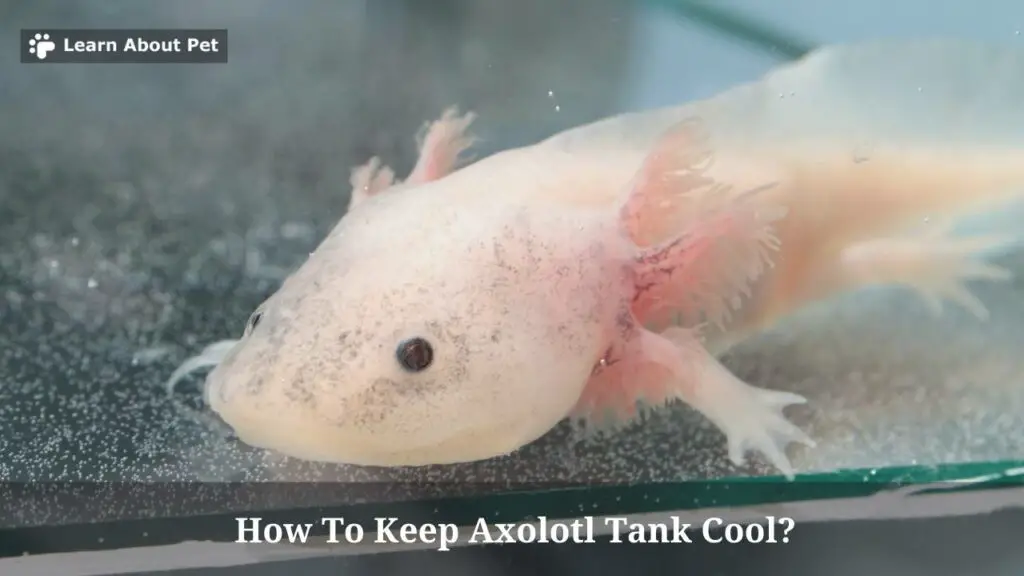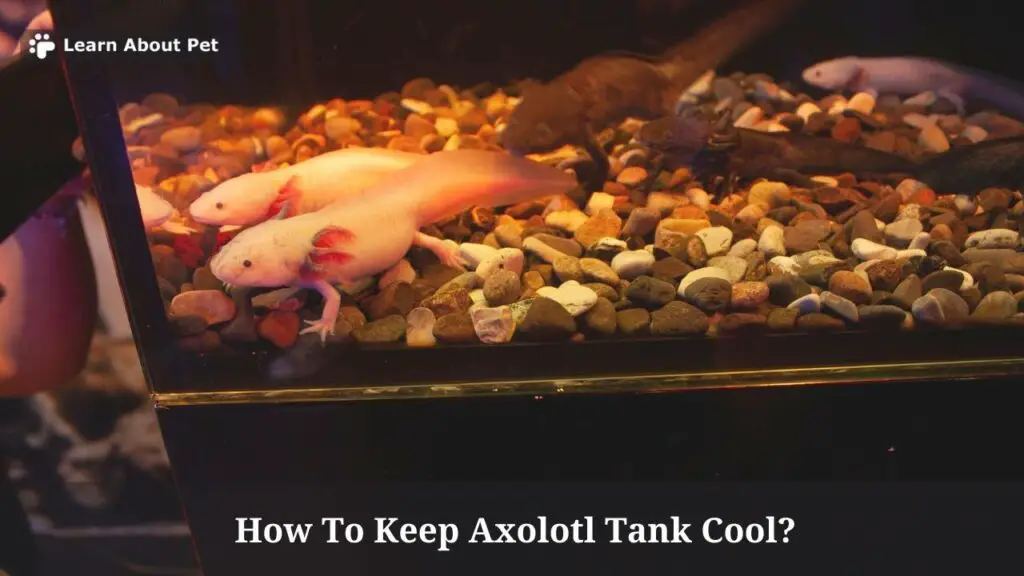One of the most challenging aspects of axolotl pet care is that of keeping the axolotl’s tank cool. Yet if your axolotl is to survive and thrive, it needs a cool tank. In this article, you will find comprehensive information on how you can keep your axolotl’s tank cool.
This is how to keep axolotl tank cool: by using an aquarium chiller, ice, air conditioning or a fan. Simply changing the axolotl tank’s location may also help greatly in keeping it cool.
The best way to cool axolotl tank will depend on how hot it is, as well as the aquarium temperature you are seeking to achieve. Much will also depend on which cooling devices are available to you.
At another level, it depends on how long-lasting a solution you need. For instance, the ideal solution for keeping axolotl cool while out of town for the weekend is different from the one for keeping the axolotl tank cool for the entire summer.

The most important thing is to appreciate that you really need to keep your axolotl’s tank cool.
Learning how to keep an axolotl tank cool is just as critical as, say, learning how to keep axolotl tank clean.
It is not something you can take for granted.
So one way or the other, you need to figure out how to cool down an axolotl tank to the appropriate level. You actually need to go beyond that, and figure out how to keep your axolotl tank cool.
Clearly, understanding how to lower the temperature in an axolotl tank is just half the equation. Over and above that, you also need to understand how to keep a tank cool for axolotl.
Why Should An Axolotl Tank Be Cool?
There is one key reason as to why an axolotl tank should be cool. That is in the fact that an axolotl can only survive and thrive if it is in a cool tank.
If an axolotl’s tank isn’t cool enough, it may not thrive. In fact, it may not survive. It may die.
Issues like axolotl temperature shock can be very scary: hence the need to keep axolotl tank cool.
So you have to find out, what temperature is too hot for axolotl? That turns out to be anything above 75 degrees Fahrenheit.
In practical terms though, an ideal temperature for axolotl tank should be between 60 and 64 degrees Fahrenheit. This translates into 16 to 18 degrees on the Celsius scale.
An axolotl may tolerate a temperature slightly above 64 degrees Fahrenheit. But if it goes beyond 75 degrees, the axolotl’s very life is at risk.
Beyond 75 degrees Fahrenheit, what may follow is axolotl heat stress. This may then lead the axolotl to lose appetite, after which the axie may sadly lose its life.
It is on account of these facts that you need to figure out how to keep axolotl tank cold.
How To Keep Axolotl Tank Cool?
We have so far established that an axolotl’s tank temperature should ideally be in the 60 to 64 degrees Fahrenheit range.
It has also become clear that a temperature above 75 degrees Fahrenheit can actually kill an axolotl.
This then leads to questions like, how do you keep an axolotl tank cool? Or in more personal (less abstract terms), how can I keep my tank cool for the axolotl?
And when it comes to the issue of how to keep my axolotl tank cool, the first recommendation is usually that of installing a chiller. So you use an aquarium chiller to keep the axolotl tank cool.
Alternatively, you can use ice cubes or bottles, to keep the axolotl tank cool. In any list of cool axolotl tank ideas, you will normally find these too.
Further, there is the option of using air conditioning or a fan. You may find a mention of these, if you research on the ultimate tips and tricks for keeping your tank cool for an axolotl.
In some cases, simply changing the location of the axolotl tank can help in cooling it down as well.
We will now proceed to look at each of these axolotl tank cooling methods in turn.
Using An Aquarium Chiller To Keep Axolotl Tank Cool
When dealing with the question of how to keep axolotl tank cool, an aquarium chiller can be very useful.
This is a device which keeps the temperature within a certain range, usually without deviating.
Does axolotl need chiller all the time? Not necessarily. But if you are in a place where warm temperatures are commonplace, then a chiller can be very helpful.
You can purchase a factory-made (and typically reliable) chiller – like, say, the Iceprobe Thermoelectric Aquarium Chiller.
Alternatively, if you have the necessary skills, time, materials and equipment, you can make your own DIY axolotl chiller.
Once you have a reliable aquarium chiller in place, and you program it well, you can have peace of mind. You know that the temperature in your axolotl tank is unlikely to ever rise to a level that can harm the axie.
But a commercial axolotl tank chiller doesn’t always come cheap.
This often leads to questions like, I can’t afford a chiller, so how do I cool down my tank for axolotl? In the first place, can you cool down an axolotl tank without a chiller?
And if yes, exactly how do you keep your axolotl tank chilled without an aquarium chiller?
The truth of the matter is that there are other ways to keep an axolotl tank cool without a chiller. They may not be as reliable as the chiller. But they can be made to work.
We now proceed to look at those other ways to keep axolotl tank cool.
Using Ice Cubes Or Bottles To Keep Axolotl Tank Cool
Ice cubes or ice bottles can have some sort of positive effect, when it comes to cooling an axolotl tank.
Thus in a discussion on how to keep axolotl tank cool, we do have to mention them.
At this point, one may ask, how exactly can I put ice in my axolotl tank? Or, to be more precise, how can I put ice cubes in my axolotl tank in a bid to keep it cool?
The answer is that you simply need to drop ice cubes into the axolotl tank water. Then you check whether you have acquired the desired temperature. If not, you gradually add more, till you get the right temperature.
If you are using an ice bottle, the secret is to submerge it. Wait for conduction to take place. Then check the water temperature, to be sure that the required level has been attained.
Under this method, you need to ensure that you have a good, constant supply of the ice aids. As soon as the initial cubes or bottle thaws, you should always have a ready replacement.
Using Air Conditioning To Keep Axolotl Tank Cool
The idea is to program the air conditioning system, so that it is at a low setting.
This will have the effect of lowering the temperature in the room with the axolotl tank.
Once the room temperature goes down, the water in the axolotl tank will also tend to become cooler.
The most challenging aspect here will be in getting the right setting, so that the water doesn’t become too cool.
You will also have to appreciate that installing and keeping an air conditioning system running can be costly.

Using A Fan To Keep Axolotl Tank Cool
The idea here is to utilize the power of the fan, to blow cool air into the area with the axolotl tank.
If the fan is effective, the air in the area with the axolotl tank will eventually become cool. Consequently, the water in the tank may also start cooling down, to the desired level.
But you need to be careful: lest the fan end up having the opposite effect of actually raising the temperature in the tank.
Keeping An axolotl Tank Cool By Changing Its Location
Sometimes, in order to keep an axolotl tank cool, all you need to do is change its location.
For instance, you may move the tank from an area in which it was under direct sunlight. Take it to a more shaded area. This may keep it cooler.
Another approach is that of moving the tank to your house’s basement. The temperatures there are likely to be lower. So this may keep the axolotl tank cooler.
Yet another approach is that of moving the tank from an area with lots of electronics. Electronic devices produce a lot of heat. If a tank is near them, it is bound to become hot.
But if you move it from close proximity to electronics, it may become cooler.
How Do You Know If An Axolotl Tank Is Cool Enough?
The way to tell if an axolotl tank is cool enough is by using a thermometer.
Ideal, this should be a thermometer that can give you a reading of the water temperature alongside that of the surrounding air temperature.
If you find it below 75 degrees Fahrenheit, then you know that it is tolerable. And if you find it in the 60 to 64 degrees Fahrenheit, then you know that it is ideal.
Final Verdict – How To Keep Axolotl Tank Cool
For an axolotl to survive and live well, it needs to be in a cool tank.
It may be hard for an axolotl to survive at any temperature above 75 degrees Fahrenheit. The ideal temperature for an axolotl is actually between 60 and 64 degrees Fahrenheit.
You can use an aquarium chiller to keep the axolotl tank cool. Ice cubes and ice bottles can also be helpful in keeping an axolotl tank cool.

In some cases, air conditioning systems and fans can help in keeping axolotl tanks cool.
There are also cases in which simply changing the location of the axolotl tank can help cool it.
That may be a question of moving it from direct sunlight, moving it to the basement or moving it from close proximity to heat-producing electronics.
As a pet lover, make sure to learn about pet more and give your pet axolotl a good and comfortable life!

Welcome to Learn About Pet. My name is Rajkumar Ravichandran and I love all pets, travel, and amazing food. I write about my passion and personal experience caring for multiple pets in this blog! ❤️
Post Disclaimer
DISCLAIMER: THIS BLOG OR WEBSITE, "Learn About Pet", DOES NOT PROVIDE YOU WITH MEDICAL ADVICE AND IS NOT A SUBSTITUTE FOR MEDICAL ADVICE. ALWAYS GET IN TOUCH WITH YOUR PERSONAL VETERINARIAN AND USE INFORMATION HERE AS GENERAL ADVICE.
The information, including but not limited to, text, graphics, images and other material contained on this website are for informational purposes only. No material on this site is intended to be a substitute for professional veterinary advice, food recommendation, diagnosis, or treatment. Always seek the advice of your veterinarian or other qualified health care provider with any questions you may have regarding a medical condition or for pet food related questions.







